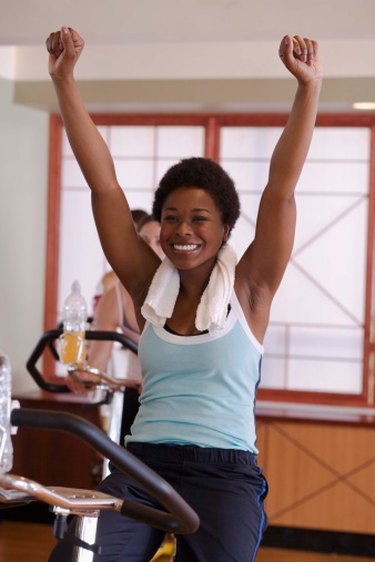
Photo retouching creates idealized images in the media, and stylists work to downplay flaws and play up assets of models and performers. Some people aren't symmetrical from one side to the other; others may seem asymmetrical when comparing the bottom half of the body to the top half. During weight loss, variations in your body's symmetry may seem more visible or pronounced. Exercise may help you condition your body to create a more symmetrical appearance.
Background
Video of the Day
The media promotes body images that are far from the norm -- most people won't look like movie stars or actors no matter how much weight they lose. Fashion models are generally ectomorphs, and only a small number of people out of the general population have this body type, dietician Sheri Barke of the College of the Canyons,, coach points out. Many people are naturally asymmetrical. For example, many women have one breast that's larger than the other. This is normal.
Video of the Day
During weight loss, the body loses fat in reverse order of where your body deposited fat when you gained weight. Changes in body composition, your ratio of muscle to fat, affect your size and body image. Muscle takes up 1/3 less space than the same weight in fat, according to Barke.
Weight Loss
For most people, weight loss shows first in the upper body and face. The areas where the body first deposits fat -- the belly in men and apple-shaped women, and for many women, the hips, buttocks and thighs -- take the longest to reduce. During the weight-loss process, this can lead to an asymmetrical bottom-heavy appearance.
Although spot training isn't considered effective -- for example, you can't lose belly fat by doing situps every day --, preliminary evidence suggests it's possible to lose more lower-body fat than upper-body fat with intermittent sprints.
Intermittent Sprinting
Researchers at the University of New South Wales found that women who engaged in intermittent sprints on exercise bicycles for 20 minutes lost more weight and body fat than a control group who pedaled at a steady rate for 40 minutes. Not only were they losing more weight in half the time, but most of the fat loss was from their legs and buttocks. The workout involved eight seconds of high-intensity pedaling followed by 12 seconds of light pedaling. This exercise method may help if losing weight causes your body to look asymmetrical due to a bottom-heavy appearance. Intermittent sprinting may be unsuitable for some people. Consult your doctor before attempting this workout.
Tips
Place a sheet of paper over one half of a face and body in several photographs. Switch the piece of paper to cover the other half of the face and body. Notice the differences. You can also use a ruler to notice how often eyes don't line up or one side is larger than another. People aren't mannikins -- having a body that's not symmetrical is natural.
To see this assymetry in motion, try taking a class, such as martial arts, tai chi or dance. It will give you exposure to people of various ages, sizes and shapes in motion -- this can help to improve acceptance of your own body.